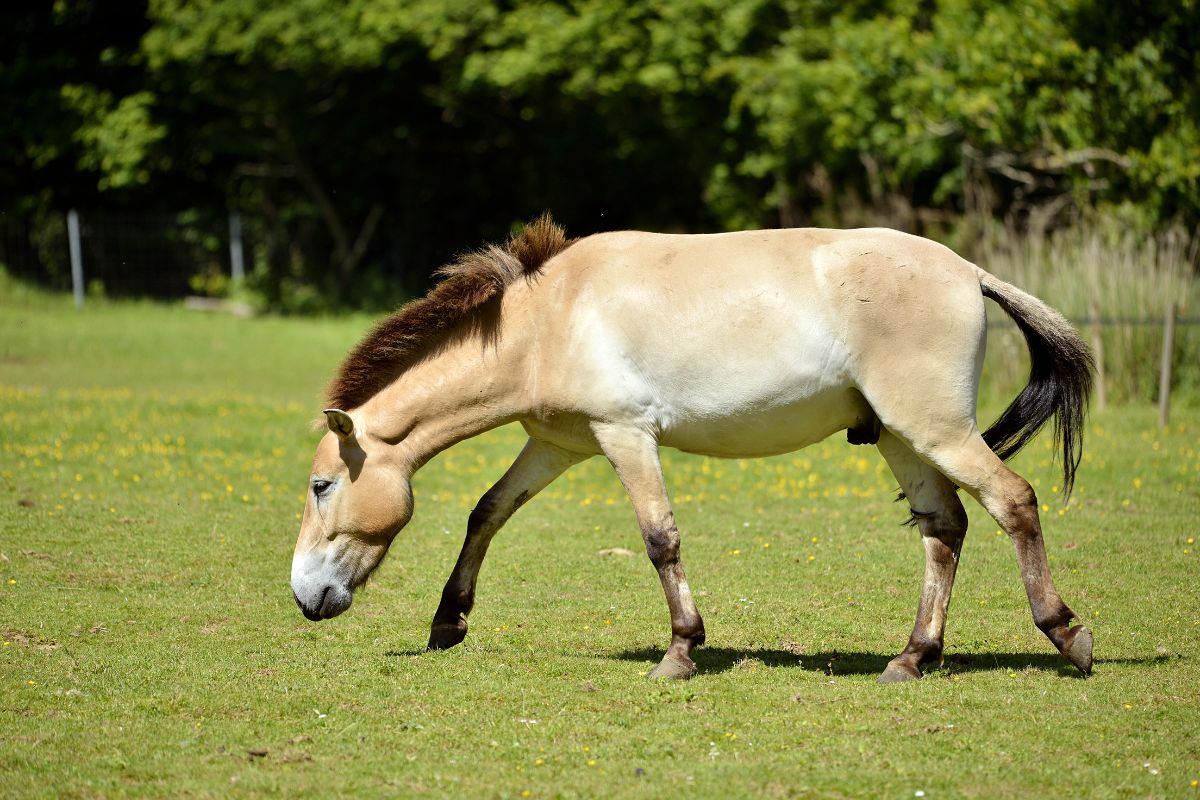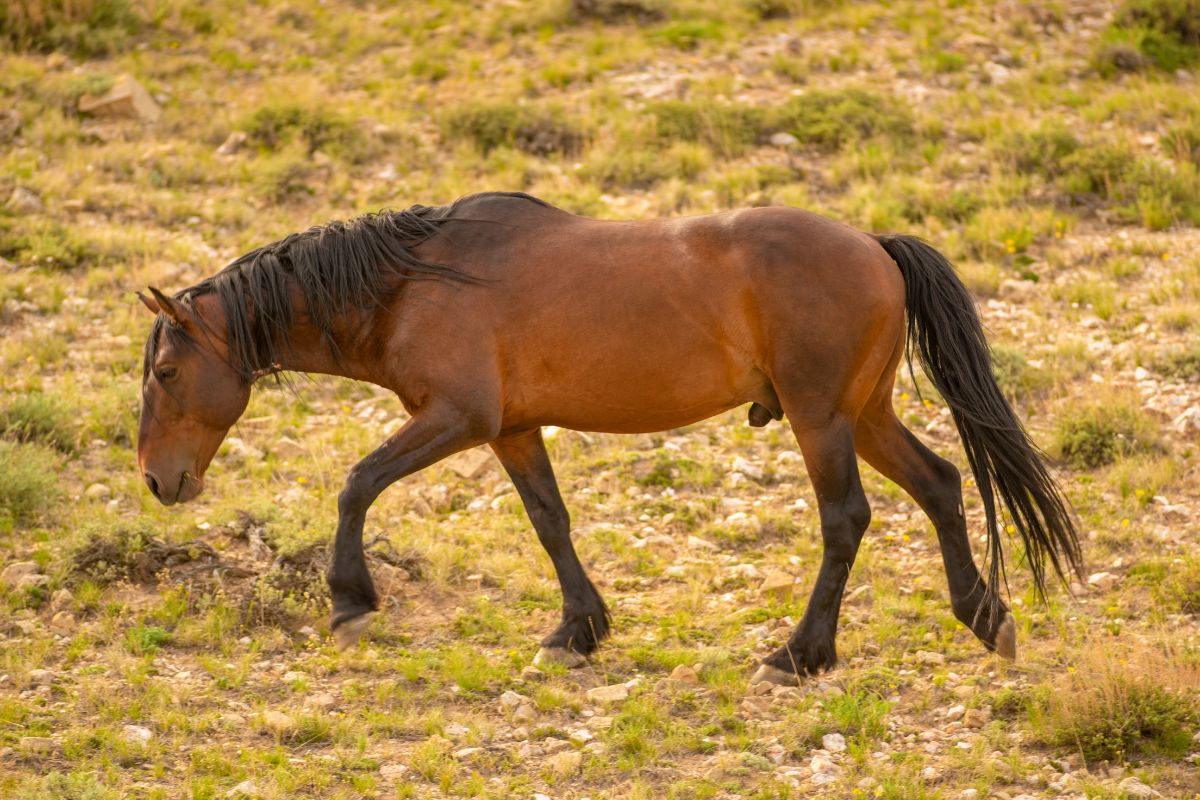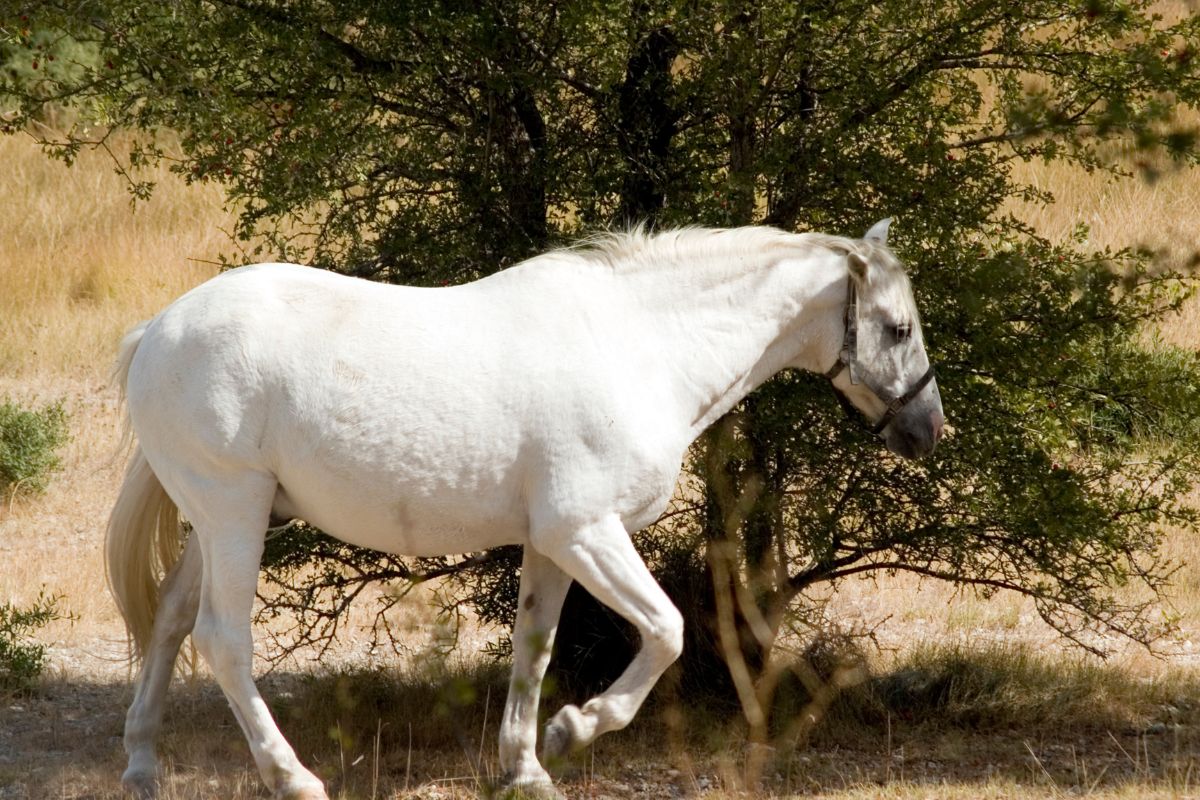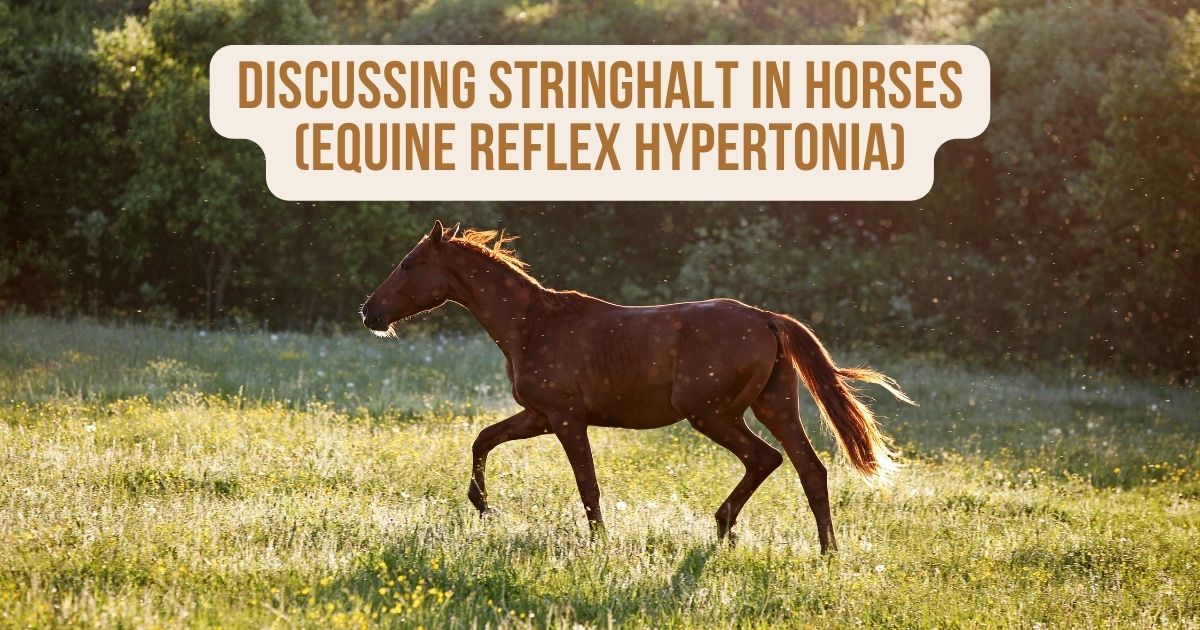What is Stringhalt in Horses?
The definition of stringhalt in horses is a neurological gait abnormality with exaggerated upward flexion of the hindlimb during each stride at a walk. Stringhalt in horses is also known as equine reflex hypertonia.
The abnormality becomes less exaggerated as a horse progresses from walk to trot and may even disappear when cantering. The condition may occur unilaterally or bilaterally and ranges from mildly intermittent occurrences to severe constant kicks that lead to secondary complications.

Clinical Signs of Equine Stringhalt
The symptoms of stringhalt have varying degrees of hyperflexion. Clinical signs range from mild spastic lifting and grounding of the hoof to more extreme cases where the involuntary sharp jerking of the leg clips the belly and then strikes the ground violently.
In chronic cases, atrophy of the lateral thigh musculature becomes evident. Although the condition occurs mainly in the hindlimbs, all four quarters and the neck can also be affected. The affected nerve fibers in the neck innervate the larynx, and horses may exhibit abnormal vocalization due to laryngeal paralysis.
In severely stringhalted horses, the condition worsens, and the horse’s gait develops a dangerous lack of balance and coordination, or the horses become recumbent. In these cases, owners consider euthanasia due to decreased quality of life and high risk of injury to themselves or others.
Symptoms are most evident during sharp turns, when the horse backs up, goes down a slope, during the first few walking steps after halting, or during gait transitions.
A few examples of clinical signs in horses with stringhalt are listed below:
- Quick motions include jerks, a slight hop, or a jump with a hind limb elevated near the stomach.
- An increase in symptom severity when turning or backing up.
- A gradual dissipation of symptoms as the horse’s gait changes from a walk to a trot, disappearing entirely at a canter.
- Unilateral or bilateral gait abnormalities become evident in the hindquarters.
- The horse may have a hopping gait when both hind legs get affected.
- A sudden, alarming self-induced kick to the abdomen can occur, followed by involuntary exaggerated flexion when walking.
- Respiratory distress may occasionally come as a result of laryngeal dysfunction.
- Grooms or horse owners may notice hard, intermittent or frequent kicking sounds in a stable or paddock.
- Clinical signs may vary from day to day. Some signs may be more severe if the horse is frightened or excited after a period of rest or during cold weather.
The following clinical sign is helpful to differentiate between stringhalt horses and horses with a locked patella. A horse with a locked patella will have the leg locked in a lower position with the hoof touching the ground, whereas stringhalt horses will hold the hyperflexed leg up high.
What Causes Stringhalt in Horses?
William Shakespeare christened stringhalt during the Renaissance period as a variation of the term springhalt. The disease occurs in horses as well as other hooved animals. The exact etiology is unknown, but researchers identified peripheral neuropathy lesions in the sciatic, peroneal, and tibial nerves.
The main types of stringhalt fall into two categories, acquired or idiopathic.
Acquired stringhalt is also known as Australian, plant-associated, pasture-associated, lathyrism, or sporadic stringhalt. Plants that are known to cause the condition are flatweed or false dandelion (Hypochaeris Radicata) and sweet peas ( Lathyrus Latifolius). The toxic principles are unclear, but peripheral nerve degeneration occurs after ingestion.
Clinical signs can occur within days of ingesting the toxin.
The disease is temporary, and symptoms resolve on their own after the removal of afflicted animals from the inciting plant source. Symptoms from plant-induced stringhalt are more intense during late summer and early fall due to the increased number of pasture weeds.
Idiopathic stringhalt is also known as true, classic, or atypical stringhalt. The etiology is unknown, but scientists suspect that traumatic damage to sensory nerves of the extensor muscles of the rear limb plays a part in the development of the disease.
Studies explored that the underlying cause may include the adhesion of the extensor tendon or injury to the sensory nerve endings in the muscle or tendon. Researchers hypothesize that the stretch receptor in the tendon undergoes a rapid hyperflexion dysfunction in the Golgi tendon organ.
No specific geographic boundaries coincide with recorded cases. The condition also does not resolve on its own. Horses that experienced neck or back injuries have shown some correlation to stringhalt cases.
Horses suffering from arthrosis (degenerative joint disease) and osteochondritis dissecans (a cartilage disorder) are also at risk of developing idiopathic stringhalt.
The symptoms experienced are not necessarily painful unless they progress into aggressive, strong jerking movements. The involuntary and forceful nature of the symptoms can result in painful kicks or secondary complications from repeated stamping of the hooves.

Diagnosing Equine Stringhalt
A thorough physical examination with a complete clinical history is vital to avoid idiolepsis in horses with abnormal gaits or neurological symptoms. Vets must check the lower pastern area for painful lesions or temporary irritations such as foreign bodies.
The clinical signs of stringhalt can provide enough evidence to make a tentative diagnosis, but confirmation through electromyography is possible. Clinicians use radiographs and ultrasound imaging to rule out muscle, tendon, or hock injuries.
Additional tests to rule out muscle diseases such as polysaccharide storage myopathy (PSSM) and infectious diseases such as equine protozoal myeloencephalitis (EPM) may be required if other tests are inconclusive.
Experienced equine vets perform a complete gait analysis to determine if other conditions may be present such as shivers. Horses will also be backed out of their stalls after hard work for 1-2 days to assess clinical symptoms’ severity and frequency.
Investigating acquired stringhalt from associated plant intoxications requires in-depth pasture and fodder assessment.
Below is a table used to grade stringhalt severity in horses as described by Huntington et al., 1989 and Domange et al., 2010.
| Grade | Description |
| 1 | Only noticeable when a horse backs, turns, or gets stressed. |
| 2 | Slight limb jerkiness when a horse moves off at a walk or trot. |
| 3 | Moderate hyperflexion when walking or trotting, especially when initiating a stopping movement. |
| 4 | Severe hyperflexion with hindlimbs hitting abdomen when backing and turning. A horse is unable to trot. |
| 5 | Hindlimb held hyperflexed for prolonged periods when initiating movement, characterized by plunging, leaping, and hopping motion. |
| 6 | Prolonged recumbency following grade 4 to 5 stringhalt gait. |
Stringhalt in Horses – Treatment & Recovery
Scientists have not yet developed a stringhalt cure, but some horses may spontaneously recover.
Stringhalt in horses’ treatment options is not definitive. In the case of plant intoxication, owners should remove horses from the contaminated pastures or paddocks. The supplier should be contacted or replaced if owners identify the contamination source as purchased feed.
Medical management for stringhalt involves the administration of muscle relaxants, anticonvulsants (phenytoin), thiamine, and tranquilizers (acepromazine), but the results often only offer temporary relief.
Thiamine (vitamin B1) functions as an essential cofactor in cell metabolism, the production of neurotransmitters, and myelin synthesis. Thiamine supplementation assists in the recovery of horses with stringhalt.
Owners can supplement their horse’s diet with antioxidants such as tocopherol (vitamin E) and ascorbic acid (vitamin C) to help reduce oxidative injury and repair nerve cells affected by ingested toxins.
In some studies, multiple Botox injections produced mild relief of stringhalt. Kinematic measurements taken during studies revealed a reduction in frequency and amplitude of hyperflexing or hyperabducting strides in the affected hindlimbs.
Electromyographically guided injections produced favorable results that could further encourage the use of Botox in stringhalt cases.
Chiropractic treatments, acupuncture, and massage can be helpful to horses with stringhalt.
Surgical management entails a myotenectomy of a part of the muscle and tendon of the lateral digital extensor at the level of the hock. The surgical procedure removes the proximal portion of the muscle and tendon that contains the Golgi tendon organs.
This treatment offers a variable success rate in chronic cases. Results may take up to 2-3 weeks before showing any improvement.
Stringhalt is known as distal axonopathy, a peripheral neuropathy resulting from a metabolic or toxic derangement of peripheral nervous system (PNS) neurons. The condition is, therefore, challenging to treat.
Recovery can take anything from 6 weeks to 24 months. Recovery can also only be partial, so it is important to remember to be patient and considerate when resting a recovering horse. Compliance is key to facilitating a full recovery, so work closely with the attending vet, nutritionist, pasture scientist, and physiotherapist.
Exercises for Stringhalt
It is not advisable to exercise horses who are suffering from stringhalt. Hard exercise can exacerbate the symptoms. Most horses with the condition have a high risk of gait abnormalities and balance or coordination problems, making them a high risk to ride or exercise.
Horses affected by stringhalt won’t do well with any groundwork or dressage. Dressage judges pay close attention to any gait irregularities, and a stringhalt horse will be severely penalized for any exaggerated, uneven, or irregular gait.
Limited abilities and frustration make stringhalt a difficult condition to work a horse ethically and productively.
Stringhalt in Horses – What’s the Prognosis?
Several factors determine the prognosis for horses suffering from stringhalt. High-performance horses will likely not return to competing but can maintain a good quality of life.
Treatment responses are unpredictable, and a diagnosis of idiopathic stringhalt carries a guarded prognosis.
Horses will remain unsound for several weeks after recovering from acquired stringhalt. Rest and rehabilitation are important if the condition leads to hind limb muscle atrophy. Physical therapy and controlled exercise programs designed by rehabilitation professionals best suit horses wishing to return to competing.
Horses with severe secondary complications may not be suitable to return to work. The constant concussive forces on the distal portions of the hind limbs may lead to bone chips, cartilage damage, or arthritis.
Owners cannot ignore the risk of relapse, and support staff must closely monitor horses for repeat symptoms to avoid secondary complications.
Idiopathic stringhalt carries the most guarded prognosis and is considered irreversible without surgery.

Final Thoughts
Avoiding acquired stringhalt in horses is achievable through proper management of pastures, paddocks, and turnouts. Some key management advice can include:
- Limited access to unimproved pastures during times of drought.
- Pastures need routine fertilizing, reseeding, and weed control.
- Make the most out of pastures by consulting specialists trained to improve pasture and make it as nutritionally rewarding as possible.
- Good quality forage is costly, but a renovated, well-cared pasture is worth the expense.
- Provide horses with alternative forage sources during droughts to ensure that horses get access to plants more palatable than weeds.
Classic stringhalt carries a guarded prognosis for horses due to the variability in their response to treatment as well as the limited treatment options available. Monitor any gait abnormalities closely and avoid secondary complications. Maintain a close watch over affected horses to act swiftly and try to get them to recover.
